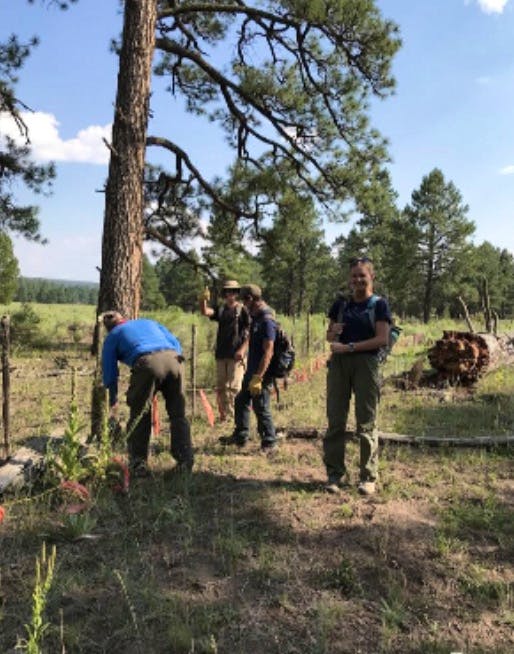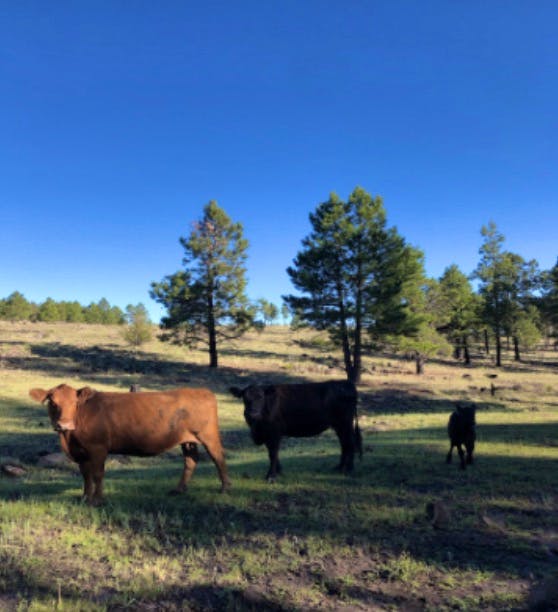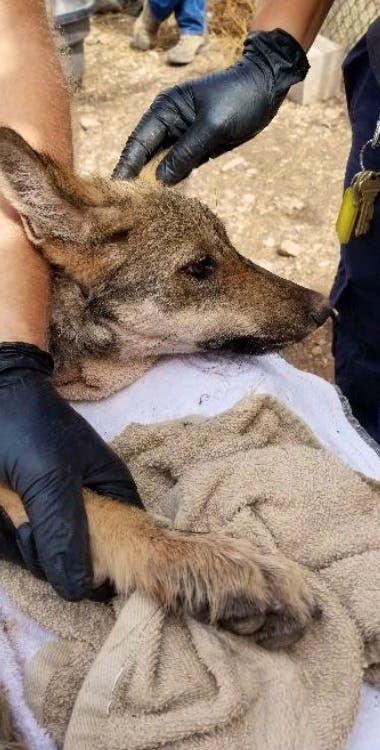The wild Mexican wolf population grew by 24% last year to a total of 163 wolves - higher than it’s been since reintroduction. This success is, in large part, due to the hard work of amazing technicians working on Mexican gray wolf recovery efforts. These dedicated volunteers are instrumental in every step of the process, from field camera monitoring to helicopter counts to one of the most successful cross-fostering events! To make this happen, Defenders teamed-up with the California Wolf Center, a captive breeding facility for Mexican gray wolves, to support a wildlife techs program, where volunteers with experience in biology and wildlife management help the U.S. Fish and Wildlife Service and Arizona Game and Fish Department to monitor wolves and implement conflict-reduction tools and techniques to give our lobos the greatest chance of success in the wild. Many of these Defenders-sponsored wildlife techs started their time with the program this spring, and we're excited to hear more from them in the next installment of Field Notes!
July 2020
When I went out searching for an abandoned den, I wasn’t sure what to expect. I struggled for more than an hour up the steep mountainside before finally arriving at the GPS point. I noticed a large gap between a few of the boulders and looked inside. The area opened up into a large den that was filled with other elk remains and some wolf fur. I was relieved that my long hike up here wouldn’t be in vain. I filled out a sheet with all the info I could collect on the den site before making my way back down the mountain and through the canyon, exhausted but satisfied.
The highlight of this past month for me was helping with making sure some of the Mexican wolf puppies in captivity were healthy and vaccinated. My day began well before sunrise as we needed to get through all the pups before it got too hot. We worked together to coral the three pups outside of the den away from the adults and into one corner. Once we had them in a corner, a couple of the biologists moved quickly to grab them and put them into crates which we quickly moved into the shade where we would be doing the check up on them.
One by one we removed the pups from their crates and weighed them. Next, we took their temperatures to make sure they weren’t overheating. We gave them a couple of vaccinations and checked to make sure they looked healthy. We also drew a small amount of blood from the pups. After giving each pup their vaccinations and checking to make sure they seemed healthy we returned them back to the rest of their pack.
Wolves are a mystery to me in many ways. The areas where it seems they ought to be or were the day before are no longer the same – they are a dynamic creature and I wonder how influenced their movements are by thousands of years of conditioning by human expansion and conflict.
The most peaceful of the activities was sign searching... I love the process of synthesizing information concerning the landscape, previously known sightings or potential evidence, and expected behaviors. The first day I went out the rains were relentless, and I was enjoying myself thoroughly. Mud and rain are the perfect conditions to sign search – tracks are much easier to identify. In terms of sign search, the question always arises for me: how much can we think like the animal we study? I inevitably start to try to think like a wolf, but I also know it would take many, many more years of working with the species...
Second of the new experiences was moving a cow carcass. This was in order to avoid drawing any wolves to the area and potentially habituate them to cow carcasses in pastures. Wow. What an unexpected experience! Not the most glorious or charming story, but certainly a great challenge and important task for avoiding human-wolf conflicts. And at least for now we gave the wolves one less reason to come to the pasture.
The past month with the Mexican wolf project brought more camera traps, food caches and searches for uncollaRed Wolf tracks. Every task, no matter how small or easy it seems, is important to our success. The most memorable experience for me was my time spent attempting to haze one of our packs away from a piece of ranchland. The rancher had reported seeing some collaRed Wolves on his property, and we needed to prevent anymore depredation of his cattle in order to protect both his cows and the wolves.
The process of hazing involves constantly listening for the wolves’ collar tag frequencies while trying to get a visual on them, or any uncollaRed Wolves, in the search area. The days were long; I was up close to sunrise to rush over to the ranch to make sure nothing happened to the cattle overnight, and I finished up in the evening when the wolves’ collars were turned off and I would no longer be able to hear their frequencies.
Some may have the misconception that working with wildlife means that you hardly have to interact with humans, but this is far from the truth. The overlap between human and animal well-being is constant and ever-present, and to achieve conservation success, we must collaborate with the people who feel they have a stake in our work. This also gives us a chance to increase awareness about what we’re doing and why it’s important, as well as to learn about the concerns of the members of the communities in which we work. We face an inevitably wide variety of opinions, but through cooperation and understanding, many projects are far more successful than they would be otherwise.
This morning I wanted to make sure the wolves were still in an appropriate location. Armed with my radio telemetry equipment, I continued driving to a place where I could listen for the wolves with my tracking antenna. As I drove down the rugged path, I began seeing disturbances in the dirt before me. They were animal tracks, lots of them. I stopped my vehicle and hopped out. The sediment that made up the road was sandy, perfect for creating impressions. The prints before me belonged to predators, complete with paw pads and claws.
As I investigated further, I noticed several lines of wolf tracks. This meant multiple wolves had used this road the night before. Only a couple months ago, I knew next to nothing about tracks, embarrassingly confusing a bear track for that of a coyote. I previously thought of tracks as mundane, even boring. As I began learning more about sign search, however, I gained a newfound appreciation for the art of tracking. Tracks tell a story. They tell, which animals travelled in a certain area and when. They tell the speed and direction of travel. They tell the size of the animal and if it travelled as a loan individual or in a family group. From looking at these tracks created the night before; I came to see a distinct story of the many predators that had used this corridor. The road was a wildlife highway, used to travel through the sheltered darkness. These tracks stretched for miles, outlining a distinct history of the night.
August 2020
This past month I have spent the majority of my time keeping food caches stocked and sorting through photos in an attempt to get accurate counts of the number of puppies in each pack. Counting the number of pups correctly can be challenging as they tend to chase each other around often running out of the shot and then reentering later... One pack recently had eight pups on camera together. It has been exciting to see just how many pups each pack has as well as being able to watch the pups grow larger from week to week
As well as stocking food caches and checking cameras, much of my time over the past month has been spent searching for signs of wolves in areas where civilians have reported seeing wolves without collars... There had been reports of three wolves being spotted in multiple different places around town very early in the morning over a few days. I went out into the field before the sun rose and scanned the areas the wolves had been spotted with my binoculars.
As I drove to the side of the valley, I crested a small hill and spotted a herd of elk. They were all standing alert and staring back up the hill towards where I had seen the shadow moving. It was obvious something had spooked them and was up on the hill. I quickly pulled over and pulled out my binoculars again and began scanning up the hillside trying to spot what the elk were looking at. After only a few seconds I spotted a wolf staring right back at me. It then turned and began to run the opposite direction and I spotted a second wolf with it. It felt good that I was able to confirm that there were in fact multiple un-collaRed Wolves in the area.
Extinction is Forever: While living in Florida, I heard about a bird called the Dusky Seaside Sparrow. It lived exclusively in the tidal marshes north of the Kennedy Space Center. This bird nested in an area that was less than ten square miles. The US Fish and Wildlife Service purchased the remaining habitat in an effort to protect the species. Unfortunately, this conservation effort was in vain. A scientist, who once observed the last Green Band perched in his cage, described the experience as witnessing extinction in progress.
Throughout the past three hundred years, a similar story can be told about many species: The Stellar sea cow, the Tasmanian tiger, or the Falkland Island wolf.
That is one of the reasons I wanted to come be a part of the Mexican gray wolf recovery program. The Mexican gray wolf was close to become another extinct species that could only be read about in books or observed in taxidermy form in a museum. But due to key intervention and the hard work of dedicated biologists, the species was saved; brought back from just seven individuals. Now there are about 163 Mexican gray wolves roaming the wilderness of the Southwest. That number is growing and their range is expanding. As a wildlife technician, I’m often asked to preform arduous tasks that are far from glamorous. While preforming these tasks, I keep a certain thought in the back of my mind. The thought that lingers in my mind is "I'm witnessing extinction in reverse." Every time I check the trail camera footage and see wolf puppies jumping around their parents, or hear a wolf howl echo off the mountains, I remind myself that in a small way, I get to be a part of keeping the Mexican gray wolf in this magnificent landscape. And if you think about it, that's pretty incredible.
The month ended with me doing sign search for the Dark Canyon pack. They had cross-fostered pups this year. Cross-fostering is when you take captive born pups and put them into a den with wild born pups of the same age, after rubbing them all over each other so they share the same scent. Wolves in the wild suffer from a genetic bottle-neck. Captive bRed Wolves from zoos and wildlife centers have valuable genes, so determining pup survival was important. I found scat my first day out looking, but some of it was too old to be genetically viable.
The next day I went out to a location where the collared adults had been just 3 and 4 days ago. Before I left my truck, I listened on the receiver to make sure they had not come back to the area, they were nowhere to be heard, so to speak. That was not surprising because there were several parties of hunters in the area, since deer season and elk archery season had started. I found lots of fresh tracks and spots where they had bedded down. I am looking forward to continuing sharing my adventures with you in the Southwest and on the Mexican Gray Wolf Project.
This month was spent doing much of the same work. Lots of food caches to help the baby wolf pups grow up healthy and strong. One of the packs I am doing food caches for was involved in a cross-foster operation. We are unsure at the moment but it is believed that multiple of her pups carry valuable genetic information. These pups will increase genetic diversity of wild wolf populations making them stronger and more likely to persist and survive in the wild in the long run. Every time I go to this food cache, I think of the little baby pups and how each week I see them on camera they look bigger and healthier. I feel fulfillment and a great sense of accomplishment on this job.
Mid-month we went to a local ranch which needed some help. There is a wolf pack in the general vicinity to one of their active cattle pastures. We don’t want the rancher to lose any of their cattle so we implemented a wolf hazing technique known as fladry. These are colorful flagging strung up along a wire around the perimeter of a cattle pasture. The strange and almost mesmerizing flagging blows in the wind and keeps wolves at bay.



September 2020
When you work with a research project long enough, you eventually become familiar with the individual animals which you are studying: what they look like, where they live or move, and how they behave. It’s easy to point out who is who when you’ve sorted through thousands of camera trap photos of a wolf pack, and it’s even better when you spend time in the field tracking or hazing them.
I’ve spent much of the past four months on the Mexican wolf recovery team focused on one of our packs, keeping them away from private ranchland and cattle, collecting scat for genetic analyses, and tracking where they moved between rendezvous sites. I often felt just one step behind them, as I spent days at a time camping out in the field, finding their sign and hearing them howl in the middle of the night. I was constantly in anticipation of a time when I may eventually catch a sighting of them, especially as the camera trap photos started to reveal that the pack was even larger than we thought. I am so proud to have played a part in this mission to recover such a precious species, and I’m excited to spend a lifetime fighting for wildlife around the world.
This month was the start of Fall. September is also the month when many of us were able to handle and collar wolves. I was finally able to work one on one with my biologist, and I enjoyed learning from her. I set my very first double long spring under a small tree, and the next morning I had captured a young female. Collaring is an important management practice on this project. Not only to be able to locate and haze them away from cattle, but also because this young female may either disperse and start a pack of her own, or if something happens to her mom, she would be the only collar left in the pack. I covered her collar in pink polka dot duct tape and sent her on her way. She was no worse for wear and was captured on camera a week later.



As my time working on the Mexican Wolf Project comes to an end, I can’t help but reminisce. This is truly a bittersweet feeling if I’ve ever felt it. This month started out with camping out close to the Mogollon Mountains in an effort to haze some wolves away from cattle. There’s something special about camping in an ecosystem with an apex predator on the landscape that makes me feel humbled. It reminds me that I am not the dominant species in these situations. Without some sort of protection, us humans would be vulnerable to attacks. I think it is important to remain humbled instead of trying to manipulate and dominate species on this planet. We need to live in harmony. We are all just trying to survive and if we are to preserve the planets abundant resources, we need to be more mindful of our decisions.
The next morning, I woke up and drove around some more to ensure the cattle were safe from wolf attacks before heading back to Alpine. I helped to gather more supplies and things we might need as the biologist I work under and I were going out to track and trap wolves the following week. Trapping is a necessary part of recovery efforts. It helps us to maintain movement patterns of wolf packs. This helps us to haze wolves when they get too close to cattle pastures. We are also able to gather genetic and other data vital to ensuring the health of wolf populations.











